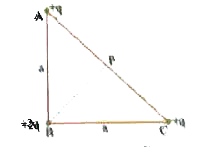The field lines for two point charges shown in fig.

(i) Is the field uniform?
(ii) Determine the ratio qA/qB.
(iii) What are the sign of qA and qB ?
(iv) Apart from infinity, where is the neutral point?
(v) If qA and qBare separated by a distance 10(√2−1) cm, find the position of neutral point.
(vi) where will the lines meet which are coming from A and are not meeting at qB?
(vii) Will a positive charge follow the line of force if free to move?
Video Solution
Text Solution
(i) No
(ii) The number of lines coming from or coming to a charge is proportial to the magnitude of the charge, so
qAqB=126=2
(iii) qA is positive and qB is negetive.
(iv) C is the other netual point.
(v) for neutral point
EA=EB⇒14πε0qA(l+x)2=14πε0qBx2
or, (l+xx)2=qAqB=2 or x=10cm
(vi) at infinity .
(vii) No, As lines of force are curved, the direction of velocity and acceleration will be different. Hence, a charge cannot follow strictly the lines of force. Also to move on some curved path, centripetal force is required. whereas the lines of force will provide only tangential force.

|
Topper's Solved these Questions
- COULOMB LAW AND ELECTRIC FIELDBOOK - CENGAGE PHYSICSCHAPTER - COULOMB LAW AND ELECTRIC FIELDEXERCISE - Solved examples
10 Videos
- COULOMB LAW AND ELECTRIC FIELDBOOK - CENGAGE PHYSICSCHAPTER - COULOMB LAW AND ELECTRIC FIELDEXERCISE - Exercises
58 Videos
- COMMUNICATION SYSTEMBOOK - CENGAGE PHYSICSCHAPTER - COMMUNICATION SYSTEMEXERCISE - QUESTION BANK
19 Videos
- Current ElectricityBOOK - CENGAGE PHYSICSCHAPTER - Current ElectricityEXERCISE - QUESTION BANK
40 Videos
Similar Questions
Knowledge Check
The positions of two point charges q1 and q2 are →r1 and →r2 , respectively. Find the position of the point where the net field is zero due to thses charges.
A→r1√q1+→r2√q2√q1+√q2B→r1√q2+→r2√q1√q1+√q2C→r1√q2+→r2√q1√q1+q2D→r1√q1+→r2√q2√q1+q2Two positive point charges q1=16μC and q2=4μC are separated in vacuum by a distance of 3.0m. Find the point on the line between the charges where the net electric field is zero.-
A2m from q1B1m from q1C2m from q2D0.5m from q1Two charge Q1=18μC and Q2=−2μC are separted by a distance R, and Q1 is on the left off Q2. The distance of the point where the net electric field is zero is
Abetween Q1 and Q2Bleft of Q1atR/2Cright of Q2 at RDright of Q2 at R/2
Consider the situation shown in (figure) what are the signs of q1 and q2 ? If the lines are drawn in proportion to the charge, what is the ratio q1q2 ?

View SolutionFigure shows the electirc field lines for two point charges separated by a distance. What are the signs of q1andq2 ? Can you determine the ratio q1∣q2 ?

View SolutionTwo point charges Q and −Q/4 are separated by a distance X. Then
 .
.
View SolutionTwo point charges q1=+2C and q2=−1C are separated by a distance d. The position on the line joining the two charges where a third charge q=+1C will be in equilibrium is at a distance
View SolutionThree charges +q, +q, +2q are arranged as shown in figure. What is the field at point P (center of side AC)

View Solution

